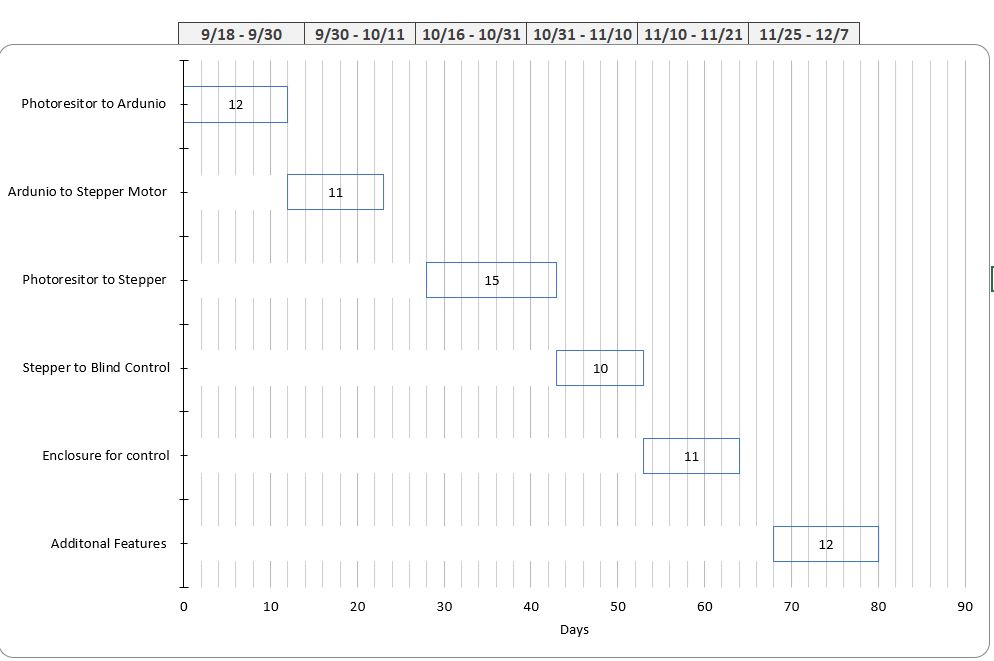Difference between revisions of "Smart Blinds"
Jump to navigation
Jump to search
| Line 9: | Line 9: | ||
*temperature input for slate control | *temperature input for slate control | ||
*timing functionality | *timing functionality | ||
| + | *designing the blind moving mechanism to work with a variety of blinds. | ||
| + | |||
=== Team members === | === Team members === | ||
| Line 27: | Line 29: | ||
*Build the frame and the blinds<br /> | *Build the frame and the blinds<br /> | ||
* Connect and test the stepper motor on the blinds<br /> | * Connect and test the stepper motor on the blinds<br /> | ||
| + | **3D print parts needed for connection | ||
**Find the correct tilting angles with regard to solar zenith angle <br /> | **Find the correct tilting angles with regard to solar zenith angle <br /> | ||
**Adjust the stepper motor to obtain the right tilting angles<br /> | **Adjust the stepper motor to obtain the right tilting angles<br /> | ||
| Line 38: | Line 41: | ||
* Learn the basis of stepper motor and its connection | * Learn the basis of stepper motor and its connection | ||
**Generate enough torque to tilt the slates | **Generate enough torque to tilt the slates | ||
| + | **Design 3D models and use 3D printing for the connection between stepper motor and blind gears | ||
**Adjust the output of motor to gain the right angle | **Adjust the output of motor to gain the right angle | ||
*Find the correlation between the temperature, luminous intensity and the proper tilting angle of the blinds | *Find the correlation between the temperature, luminous intensity and the proper tilting angle of the blinds | ||
Revision as of 16:22, 21 September 2018
Contents
Proposal
Overview
The goal of this project is to create a set of blinds that is able to automatically adjust the tilting angles of the slates with real time luminosity. The blinds will also feature an timing function which will drive the blinds to open and close at certain time according to user's preference. The apparatus will contain a stepper motor to open the shades and an Arduino processor will be incorporated to measure the luminosity. In order to achieve the project goal, data obtained by the Arduino sensor will be processed and transmitted to the step motor.
If time allows we will add these additional features:
- temperature input for slate control
- timing functionality
- designing the blind moving mechanism to work with a variety of blinds.
Team members
- Xinquan Liu (Toby)
- Sam LaSota
TA: William Berndt Parkinson
Objectives
Electronics and programming
- Find the position to place the temperature and luminous intensity sensor so that it will yield the most precise feedback
- Program the Arduino to obtain the correct inputs of temperature and luminous intensity
- Analyze the data obtained and filtered the noise in the signals
- Transform the inputs of temperature and luminous intensity to proper outputs to the stepper motor
- Analyze the data obtained and filtered the noise in the signals
- Make sure the stepper motor interact correctly with the Arduino
Mechanics
- Build the frame and the blinds
- Connect and test the stepper motor on the blinds
- 3D print parts needed for connection
- Find the correct tilting angles with regard to solar zenith angle
- Adjust the stepper motor to obtain the right tilting angles
- Make sure the right connection between step motor, power source, transistor, and the Arduino
- Visually appealing setup
- Save energy as much as possible
Challenges
- Build the frame and fit in the blinds
- Learn the basis of stepper motor and its connection
- Generate enough torque to tilt the slates
- Design 3D models and use 3D printing for the connection between stepper motor and blind gears
- Adjust the output of motor to gain the right angle
- Find the correlation between the temperature, luminous intensity and the proper tilting angle of the blinds
- Probably will require many experiments and tests at different times of the day
- Program the Arduino to collect and process the data
- Collect precise and enough data to determine the output from Arduino to the motor
- Filter the noise in the data so that the motor will only function when needed
- Transform the input data to the right output signals and transmit them to the motor
- Translate stepper motor torque into blind control using 3-d printed parts
Budget
- Achim Home Furnishings 1-Inch Wide Window Blinds, 24 by 64-Inch, White $11.99 (Amazon)
- Motor and Driver $8.59 (Amazon)
- 28BYJ-48 DC 5V Stepper Motor
- ULN2003 Driver Test Module Board
- 28BYJ-48 DC 5V Stepper Motor
- Arduino Uno $17.99
- Digital Light Intensity Sensor Module for Arduino UNO $5.99
- DHT22 Temperature Humidity Sensor Module $10.99
